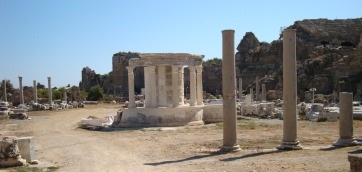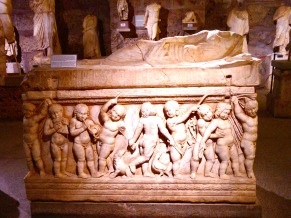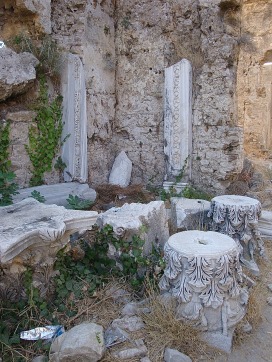“Pomegranate” Population: 14,500
Other names: Selimiye, Eski Adalyia
Market day: Saturday
Festival: Side International Culture & Art Festival (mid-August-September)
Side, on the south coast of Turkey just east of Antalya, is one of those places that independent travellers tend to shy away from, horrified to discover that what must once have been an idyllic fishing village set around a gorgeous sandy beach and a cluster of ancient ruins has developed into a full-blown tourist resort.
But the ruins at Side are extraordinarily impressive and the good news is that efforts to smarten things up have worked well, with the town a far nicer place to visit than it used to be.
Backstory
The original settlement seems to have been the work of Aeolians from Greece who arrived here c. 600 BC, and made a living from piracy and the slave trade. In due course their town was subsumed into the Roman Empire as part of Pamphylia and seems to have settled down as a trading centre with a population of around 60,000 people. This flourished into the Byzantine period, only to fall on hard times when the Arabs came calling in the 7th century.
For ages nothing much seems to have happened in Side, then in the late 19th century fresh blood sailed in from Crete and things started to look up again. In the early 20th century most residents still made their living from the sea. It was only in the 1980s that mass tourism brought drastic change.
Around town
Most independent travellers arrive in Side via the small town of Manavgat where you change to a minibus for the run down to Side’s diminutive otogar. From there you can either stroll into town via the evocative remains of a porticoed Roman street lined with shops or pay a small fee to be ferried there by bus.
If you walk you will come almost at once to a huge nymphaeum (fountain) which faces along the ancient street leading to the theatre. This is one of Side’s more enchanting areas and well worth lingering to explore, not least because so few other people bother to do so. Excavations have uncovered the remains of shops on either side of the road, a reminder that the determined commerce of the modern village is hardly anything new.
 As you near Side proper you pass the remains of the commercial agora (marketplace), where slaves were once sold. The cute little round temple to Tyche in its centre has been completely restored.
As you near Side proper you pass the remains of the commercial agora (marketplace), where slaves were once sold. The cute little round temple to Tyche in its centre has been completely restored.
Immediately across the road Side’s fine small archaeology museum (closed Mondays) is housed inside a 5th-century Roman bath-house. It contains an impressive collection of marble statues and sarcophagi as well as an inscription in Luwian, the ancient language spoken here in which the word “side” meant “pomegranate”.
At this point the road makes a sharp turn to the right, passing through one of the old city gates. Attached to it is a monument to Vespasian moved here to serve as a fountain once its original purpose came to an end.
Right beside the arch is the huge ancient theatre (look out for its semi-circular toilet block on the side facing the agora) which was built in the second century, almost certainly over the foundations of an earlier theatre. It could probably have seated up to 15,000 people at a time, who came here to watch gladiators in combat with wild animals.
Unlike most Anatolian theatres, Side’s is free-standing rather than cut into a hillside, thereby necessitating the building of huge retaining walls.
The village’s other main sites are the twin Temples of Apollo and Athena at the far end of the promontory that formed the heart of the ancient settlement. Some of the Corinthian columns from the Temple of Athena have been re-erected and make a romantic backdrop for photographs, reminiscent in some ways of Cape Sounion in Greece.
For most visitors that is as far as the sightseeing goes but actually the wonderful thing about Side is the way that the modern village is intertwined with the ancient town so that you’ll stumble across the remains of two huge bathhouses – the Harbour Baths and the Great Baths – while looking for somewhere to eat and will stroll past the remains of the old sea walls as you look for somewhere to stay.
You’ll also spot the remains of a Temple to Men (a moon god) hunkered down amongst the restaurants on the peninsula.
Some of the most impressive ruins are strewn across the wasteland between the commercial agora and the main beach. Here you’ll find the remains of a Byzantine bishop’s palace with what must have been a spectacular private chapel to judge from the remaining marble columns; a two-story building that may have been a Byzantine hospital; and the state agora where most of the government buildings stood and which once boasted a wall of sculptures associated with the cult of the emperor as deity. Byzantine bishop’s palace
Byzantine bishop’s palace
Of course Side also has some lovely stretches of sandy beach, making this a great place for a family holiday.
Eating
Prices are high in Side and it pays to be a bit careful when ordering, especially when it comes to fish, since past customers have sometimes found themselves landed with unexpectedly large bills. If you stick with the tried and tested restaurants such as the Aphrodite, Moonlight and Soundwaves you shouldn’t go far wrong.
Sleeping
Hotel Can Garden Beach
With one entrance opening through the old sea walls to the beach and another opening through the colonnaded street, the Hotel Can Garden Beach could hardly be in a better location for history lovers. Throw in the glorious garden and pool and this might be the place of first choice although inevitably the prices are steep.
Tel: 0242-753 3240
Side Hotel. Tel: 0242-753 3824
Yüksel Pansiyon.Tel: 0242-753 2010
Transport info
There are frequent buses from Antalya and Alanya to Side via Manavgat.
Day trip destinations
Seleucia in Pamphylia


